Flag Engineered for Space - Saturn
Planet: Saturn
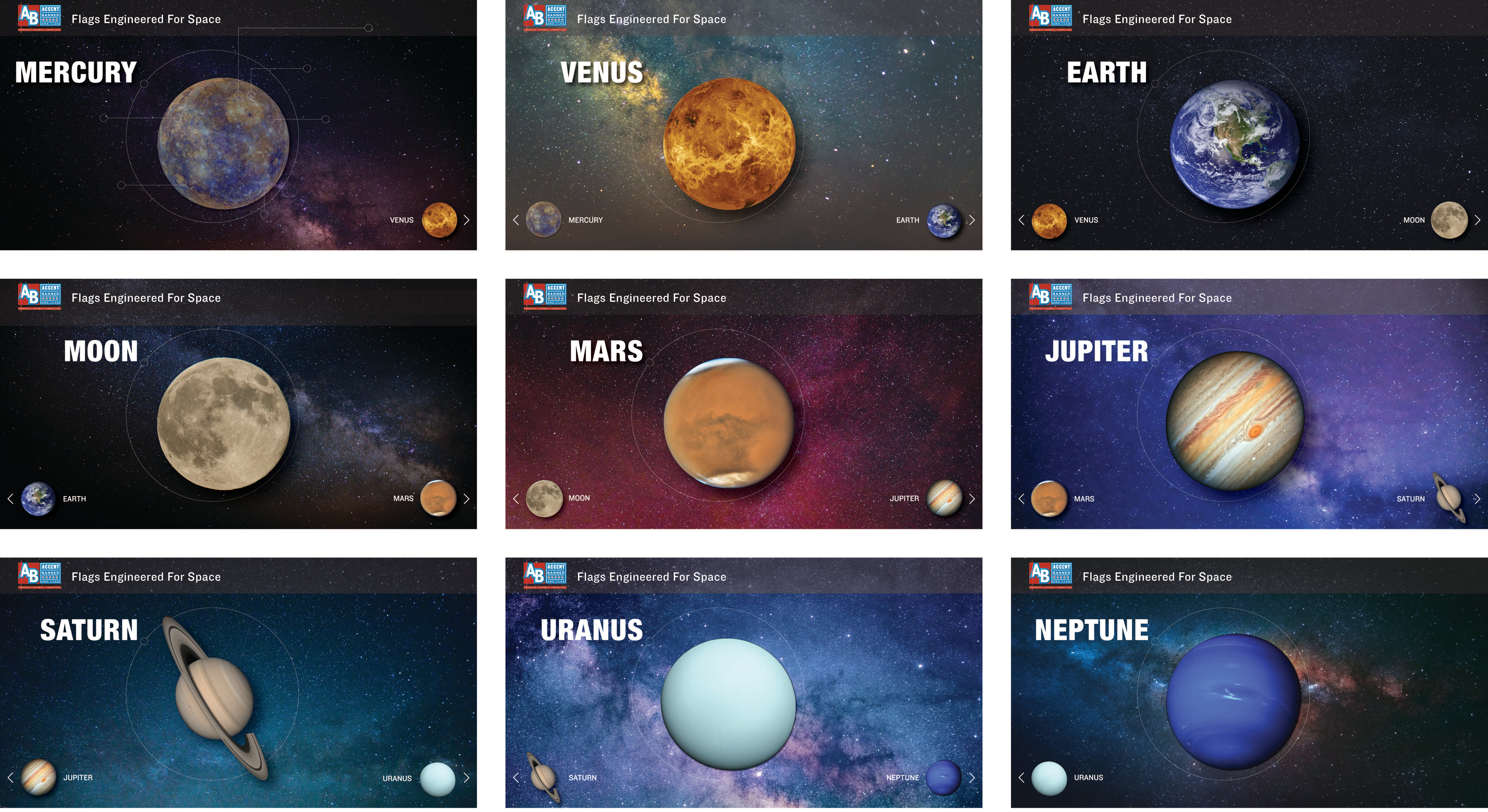
Ever wondered how flags are designed to withstand and go against gravity to fly up in the air. Flags are one of the oldest inventions by mankind serving various purposes through history. One of the least credited product design wonders which takes into consideration the outdoor conditions our planet earth has to offer. Makes you wonder the conditions one needs to factor in while designing a flag for other planets in our solar system. Peek into few of the geographic, climatic and surface temperatures one needs to factor in for designing flags in other celestial planets and few material suggestions we believe could work.
Mercury
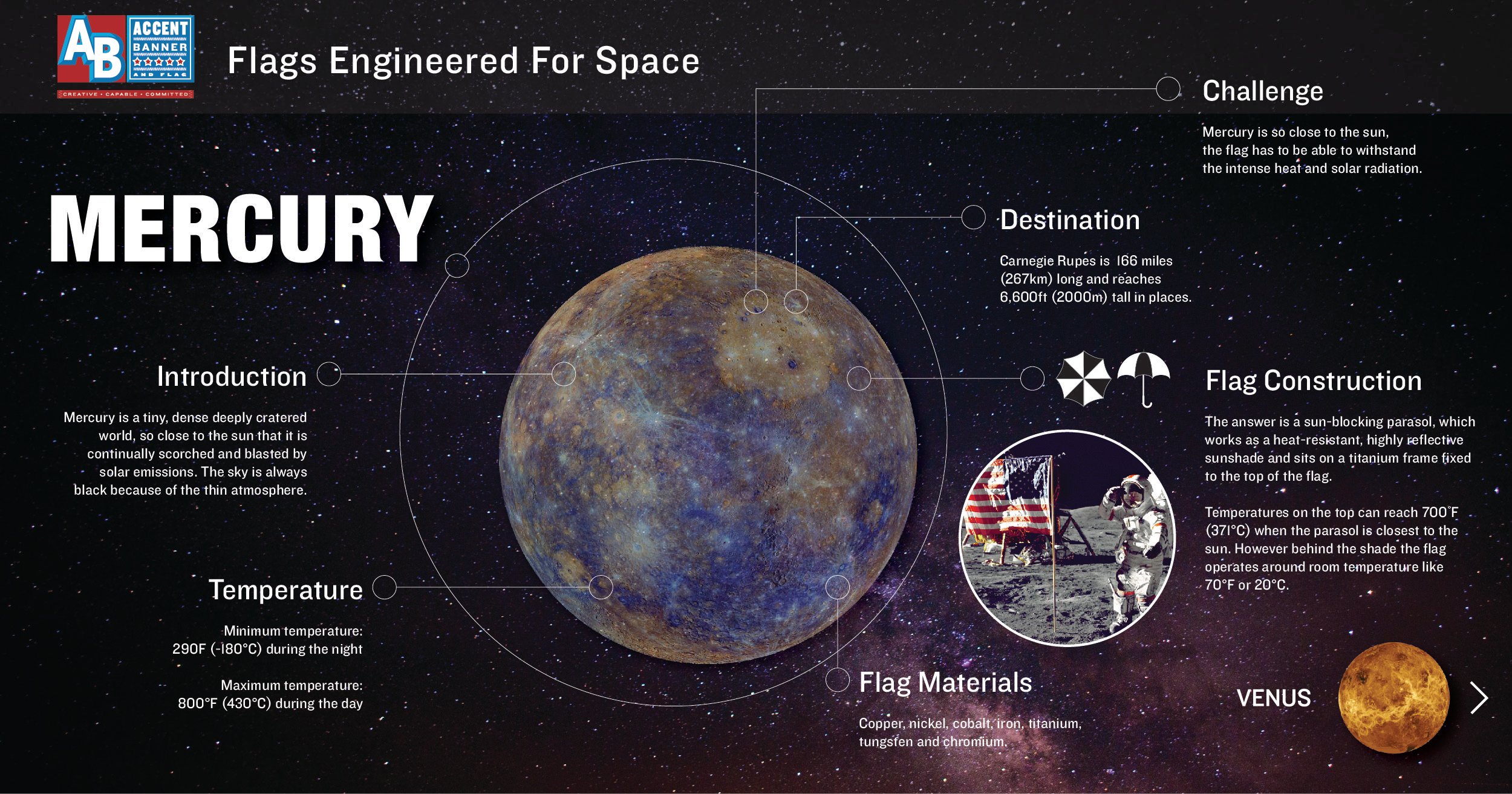
Mercury is a tiny, dense deeply cratered world, so close to the sun that it is continually scorched and blasted by solar emissions. The sky is always black because of the thin atmosphere.
Temperature:
Minimum temperature: 290F (-180°C) during the night
Maximum temperature: 800°F (430°C) during the day
Challenge
Mercury is so close to the sun, the flag has to be able to withstand the intense heat and solar radiation.
Destination
Carnegie Rupes is 166 miles (267km) long and reaches 6,600ft (2000m) tall in places.
Flag Construction
The answer is a sun-blocking parasol, which works as a heat-resistant, highly reflective sunshade and sits on a titanium frame fixed to the top of the flag. Temperatures on the top can reach 700˚F (371°C) when the parasol is closest to the sun. However behind the shade the flag operates around room temperature like
70°F or 20°C.
Flag Materials
Copper, nickel, cobalt, iron, titanium, tungsten and chromium.
Venus
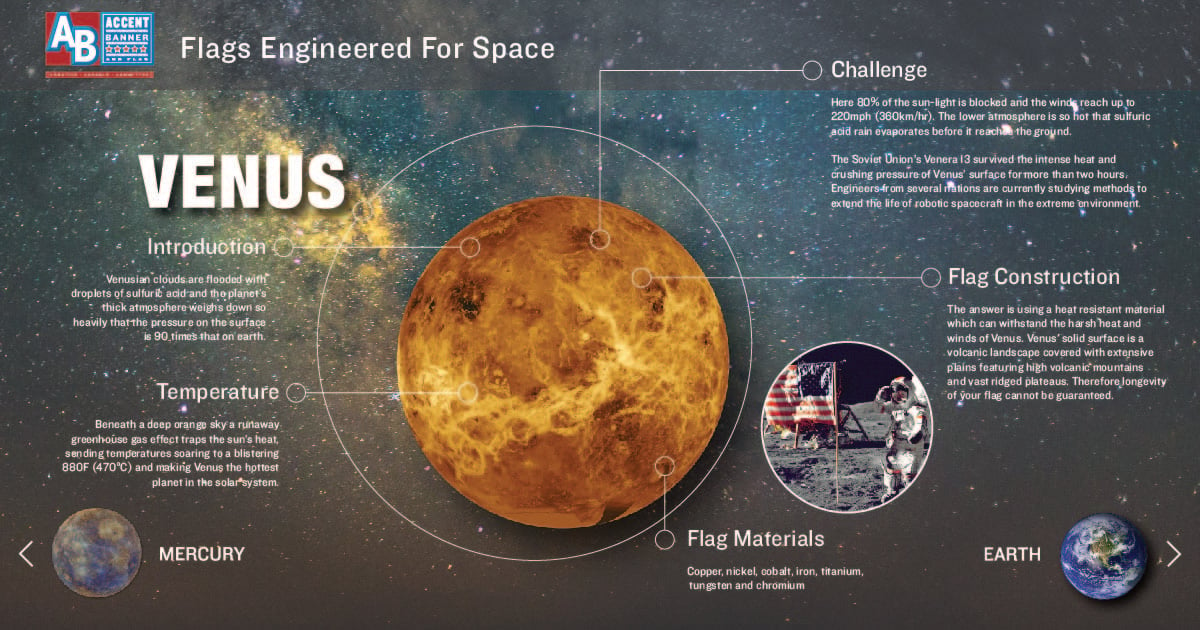
Introduction
Venusian clouds are flooded with droplets of sulfuric acid and the planet’s thick atmosphere weighs down so heavily that the pressure on the surface is 90 times that on earth.
Temperature
Beneath a deep orange sky a runaway greenhouse gas effect traps the sun’s heat, sending temperatures soaring to a blistering 880F (470°C) and making Venus the hottest planet in the solar system.
Challenge
Here 80% of the sun-light is blocked and the winds reach up to 220mph (360km/hr.). The lower atmosphere is so hot that sulfuric acid rain evaporates before it reaches the ground. The Soviet Union’s Venera 13 survived the intense heat and crushing pressure of Venus’ surface for more than two hours. Engineers from several nations are currently studying methods to extend the life of robotic spacecraft in the extreme environment.
Flag Construction
The answer is using a heat resistant material which can withstand the harsh heat and winds of Venus. Venus' solid surface is a volcanic landscape covered with extensive plains featuring high volcanic mountains and vast ridged plateaus. Therefore longevity of your flag cannot be guaranteed.
Flag Materials
Copper, nickel, cobalt, iron, titanium, tungsten and chromium.
Earth
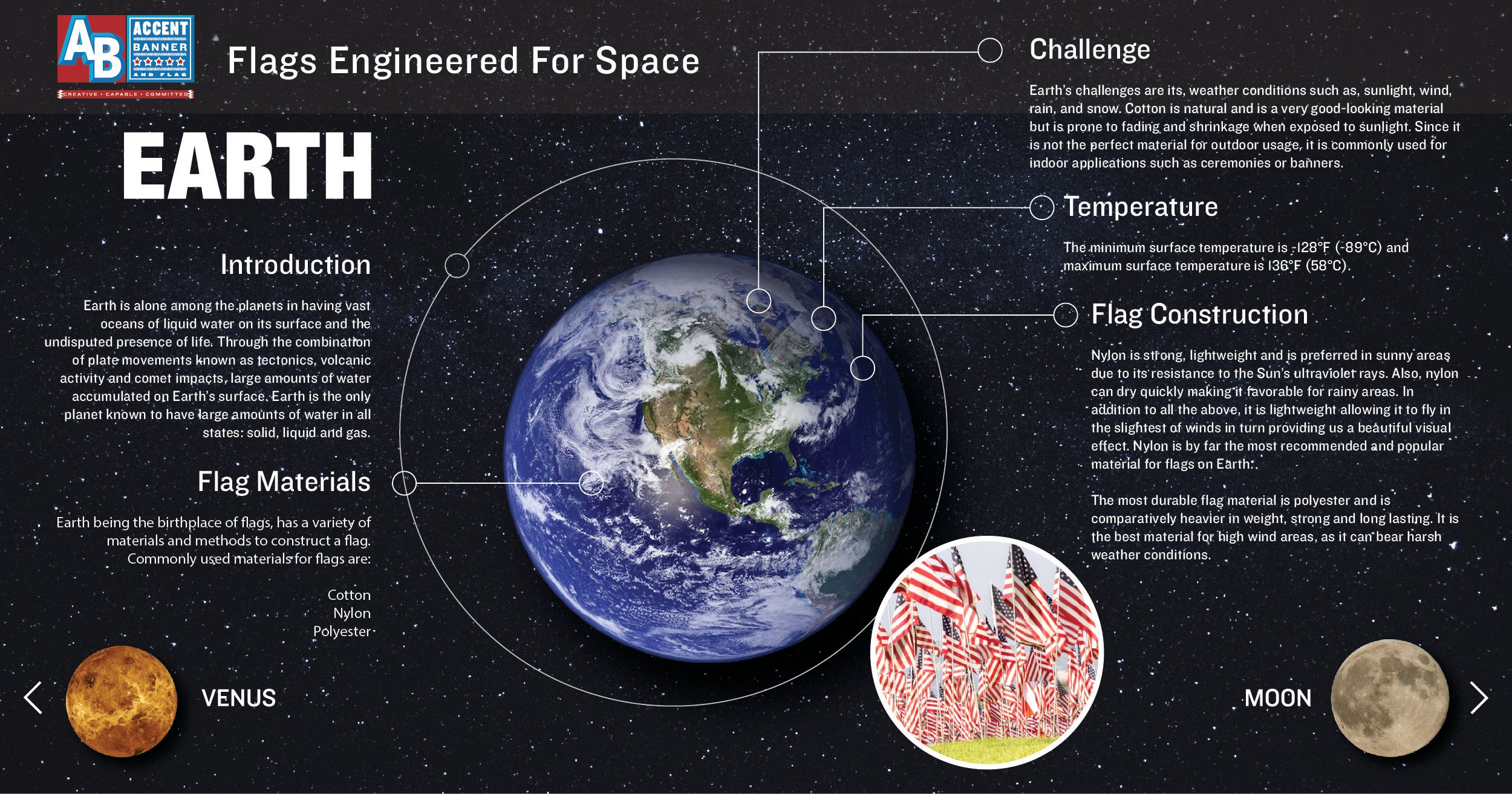
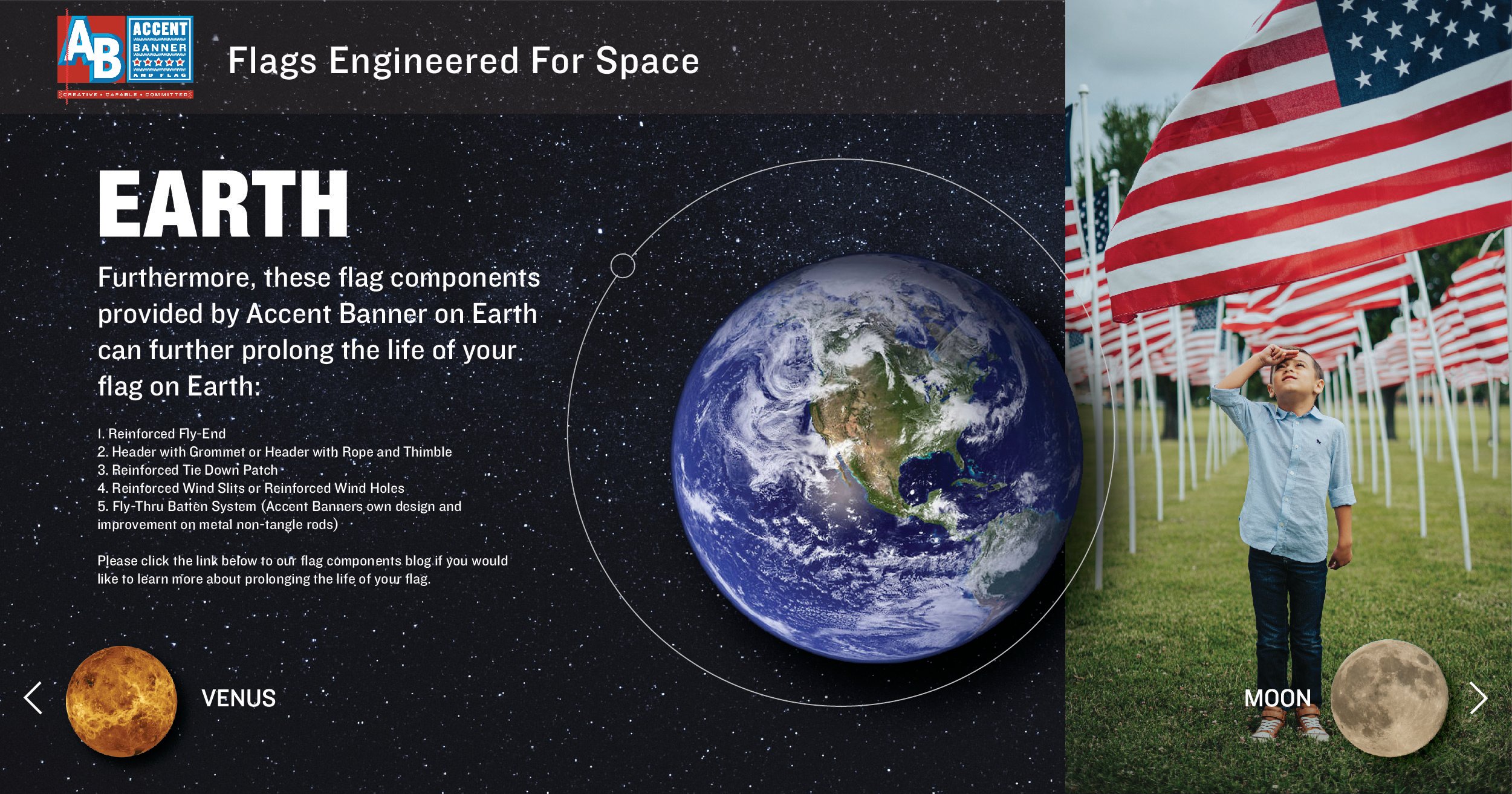
Introduction
Earth is alone among the planets in having vast oceans of liquid water on its surface and the undisputed presence of life. Through the combination of plate movements known as tectonics, volcanic activity and comet impacts, large amounts of water accumulated on Earth’s surface. Earth is the only planet known to have large amounts of water in all states: solid, liquid and gas.
Flag Materials
Earth being the birthplace of flags, has a variety of materials and methods to construct a flag. Commonly used materials for flags are:
Cotton, Nylon and Polyester
Challenge
Earth’s challenges are its, weather conditions such as, sunlight, wind, rain, and snow. Cotton is natural and is a very good-looking material but is prone to fading and shrinkage when exposed to sunlight. Since it is not the perfect material for outdoor usage, it is commonly used for indoor applications such as ceremonies or banners.
Temperature
The minimum surface temperature is -128°F (-89°C) and maximum surface temperature is 136°F (58°C).
Flag Construction
Nylon is strong, lightweight and is preferred in sunny areas due to its resistance to the Sun’s ultraviolet rays. Also, nylon can dry quickly making it favorable for rainy areas. In addition to all the above, it is lightweight allowing it to fly in the slightest of winds in turn providing us a beautiful visual effect. Nylon is by far the most recommended and popular material for flags on Earth.
The most durable flag material is polyester and is comparatively heavier in weight, strong and long lasting. It is the best material for high wind areas, as it can bear harsh weather conditions.
Furthermore, these flag components provided by Accent Banner on Earth can further prolong the life of your flag on Earth:
1. Reinforced Fly-End
2. Header with Grommet or Header with Rope and Thimble
3. Reinforced Tie Down Patch
4. Reinforced Wind Slits or Reinforced Wind Holes
5. Fly-Thru Batten System (Accent Banners own design and improvement on metal non-tangle rods)
Please click the link below to our flag components blog if you would like to learn more about prolonging the life of your flag.
http://www.accentbanner.com/blog/5-flag-components-to-make-your-flags-more-wind-resistant
Moon
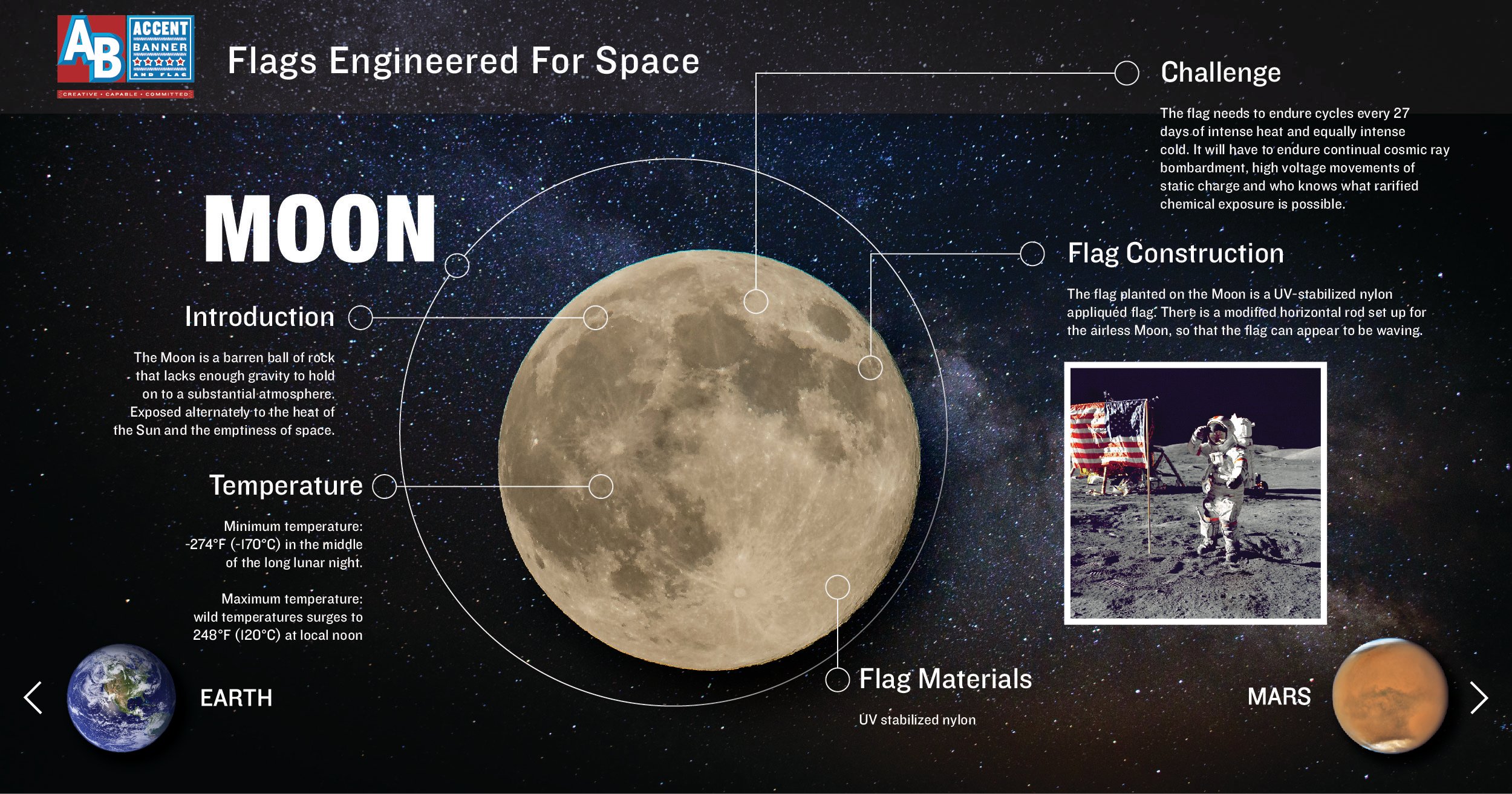
The Moon is a barren ball of rock that lacks enough gravity to hold on to a substantial atmosphere. Exposed alternately to the heat of the Sun and the emptiness of space, the lunar surface experiences wild temperatures surging from 248°F (120°C) at local noon to -274°F (-170°C) in the middle of the long lunar night. The flag planted on the Moon is a UV-stabilized nylon appliquéd flag. There is a modified horizontal rod set up for the airless Moon, so that the flag can appear to be waving. The flag needs to endure cycles every 27 days of intense heat and equally intense cold. It will have to endure continual cosmic ray bombardment, high voltage movements of static charge and who knows what rarified chemical exposure is possible.
Mars
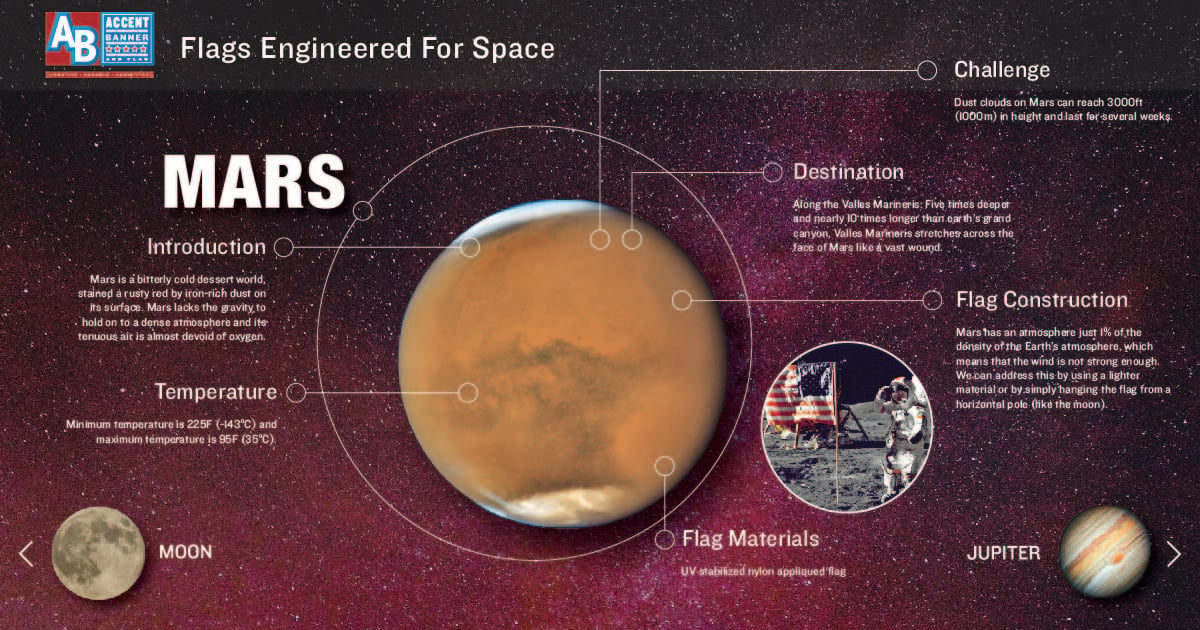
Mars is a bitterly cold dessert world, stained a rusty red by iron-rich dust on its surface. Mars lacks the gravity to hold on to a dense atmosphere and its tenuous air is almost devoid of oxygen. Dust clouds on Mars can reach 3000ft (1000m) in height and last for several weeks. Minimum temperature is 225F (-143c) and maximum temperature is 95F (35C).
Mars has an atmosphere just 1% of the density of the Earth’s atmosphere, which means that the wind is not strong enough to address this by using a lighter material or by simply hanging the flag from a horizontal pole (like the moon). We can use the AB Fly-Tru Batten System.
Destination: Along the Valles Marineris
Five times deeper and nearly 10 times longer than earth’s grand canyon, Valles Marineris stretches across the face of Mars like a vast wound.
Jupiter
Moon: Europa
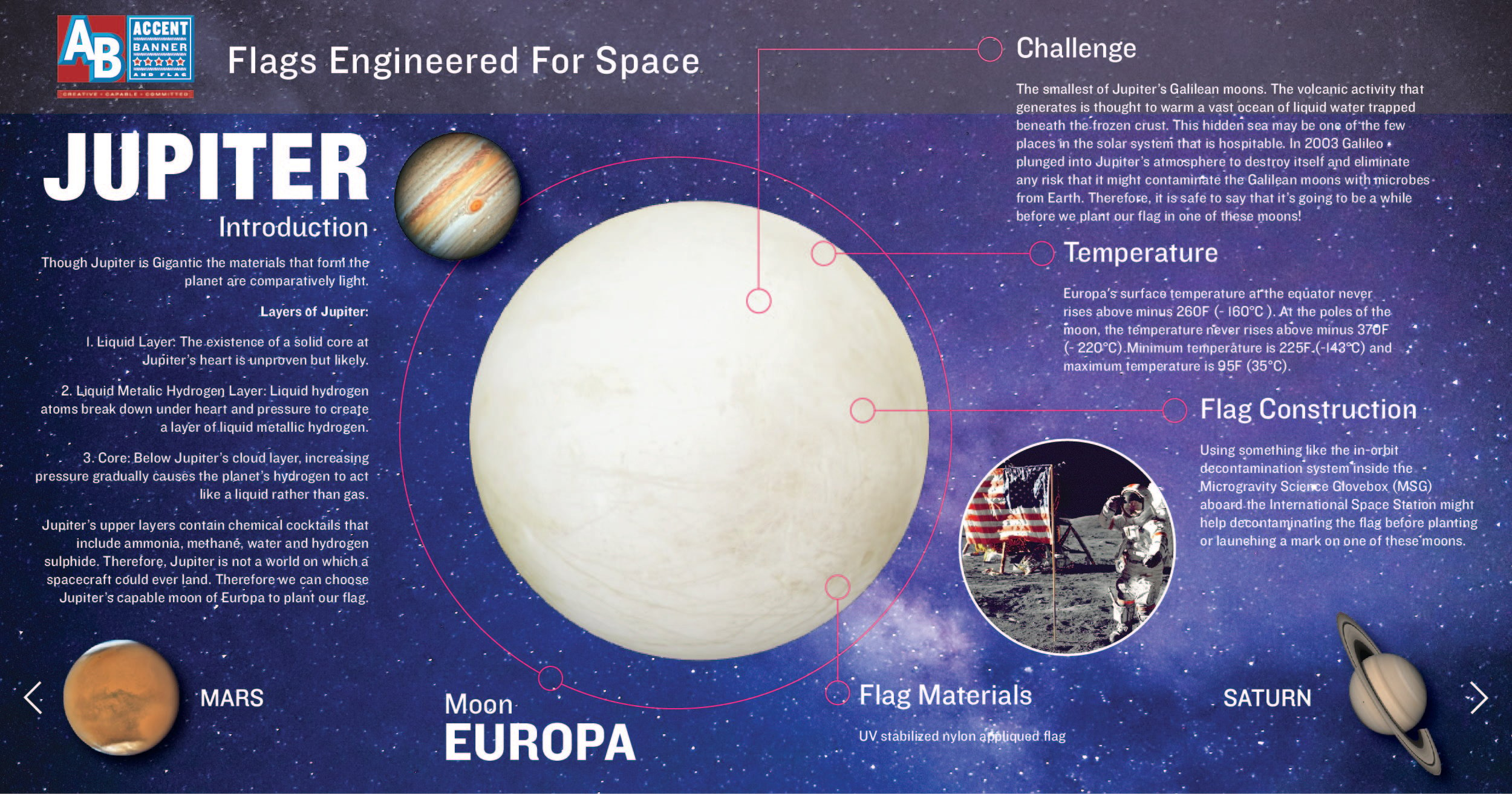
Introduction
Though Jupiter is Gigantic the materials that form the planet are comparatively light. Layers of Jupiter:
1. Liquid Layer: The existence of a solid core at Jupiter’s heart is unproven but likely.
2. Liquid Metallic Hydrogen Layer: Liquid hydrogen atoms break down under heart and pressure to create a layer of liquid metallic hydrogen.
3. Core: Below Jupiter’s cloud layer, increasing pressure gradually causes the planet’s hydrogen to act like a liquid rather than gas.
Jupiter’s upper layers contain chemical cocktails that include ammonia, methane, water and hydrogen sulphide. Therefore, Jupiter is not a world on which a spacecraft could ever land. Therefore we can choose Jupiter’s capable moon of Europa to plant our flag.
Challenge
The smallest of Jupiter’s Galilean moons. The volcanic activity that generates is thought to warm a vast ocean of liquid water trapped beneath the frozen crust. This hidden sea may be one of the few places in the solar system that is hospitable. In 2003 Galileo plunged into Jupiter’s atmosphere to destroy itself and eliminate any risk that it might contaminate the Galilean moons with microbes from Earth. Therefore, it is safe to say that it’s going to be a while before we plant our flag in one of these moons!
Temperature
Europa's surface temperature at the equator never rises above minus 260F (- 160°C ). At the poles of the moon, the temperature never rises above minus 370F (- 220°C).Minimum temperature is 225F (-143°C) and maximum temperature is 95F (35°C).
Flag Construction
Using something like the in-orbit decontamination system inside the Microgravity Science Glovebox (MSG) aboard the International Space Station might help decontaminating the flag before planting or launching a mark on one of these moons.
Flag Materials
UV stabilized nylon appliqued flag
Saturn
Moon: Enceladus
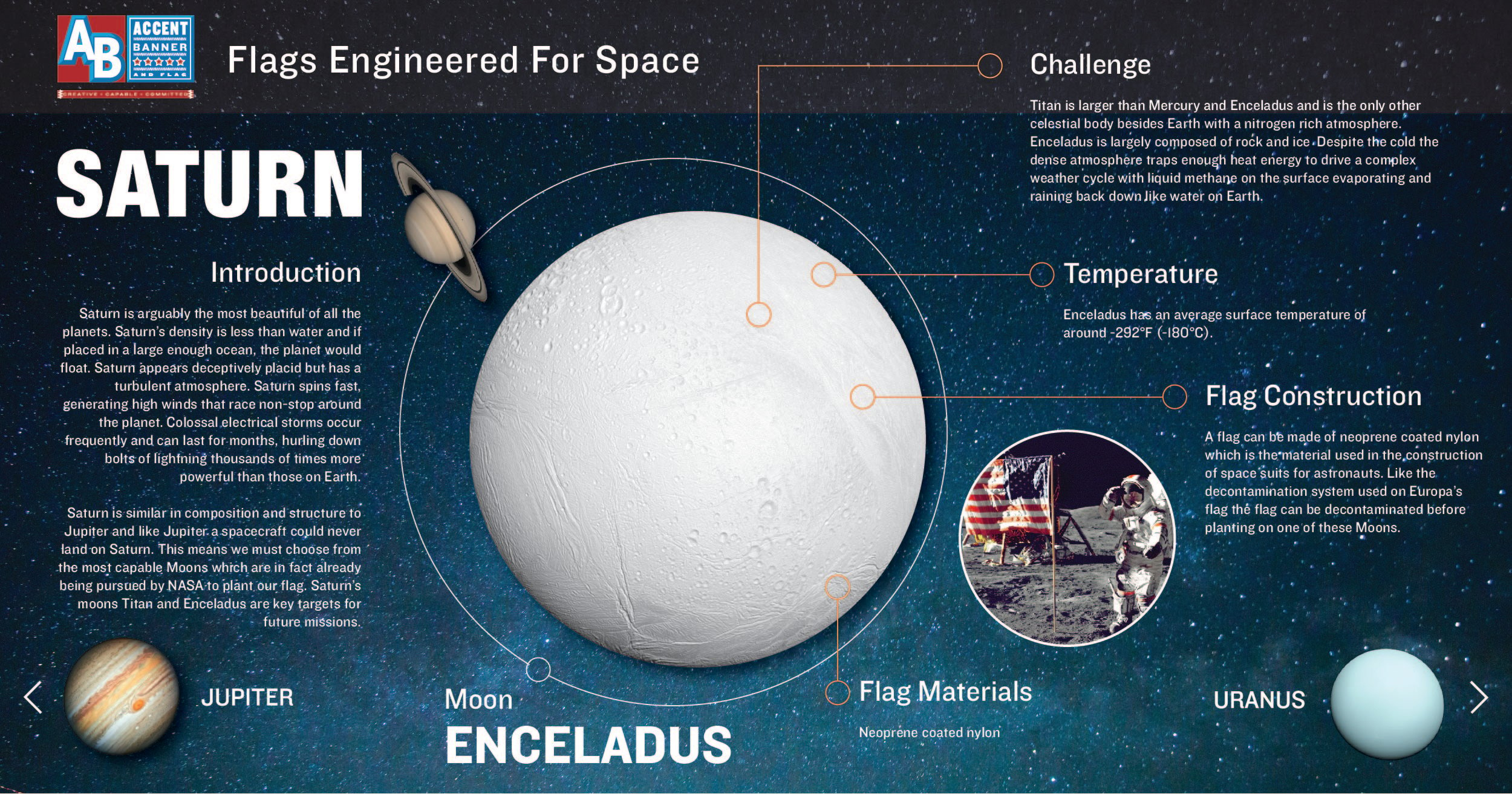
Introduction
Saturn is arguably the most beautiful of all the planets. Saturn’s density is less than water and if placed in a large enough ocean, the planet would float. Saturn appears deceptively placid but has a turbulent atmosphere. Saturn spins fast, generating high winds that race non-stop around the planet. Colossal electrical storms occur frequently and can last for months, hurling down bolts of lightning thousands of times more powerful than those on Earth.
Saturn is similar in composition and structure to Jupiter and like Jupiter a spacecraft could never land on Saturn. This means we must choose from the most capable Moons which are in fact already being pursued by NASA to plant our flag. Saturn’s moons Titan and Enceladus are key targets for future missions.
Challenge
Titan is larger than Mercury and Enceladus and is the only other celestial body besides Earth with a nitrogen rich atmosphere. Enceladus is largely composed of rock and ice Despite the cold the dense atmosphere traps enough heat energy to drive a complex weather cycle with liquid methane on the surface evaporating and raining back down like water on Earth.
Temperature
Enceladus has an average surface temperature of around -292°F (-180°C).
Flag Construction
A flag can be made of neoprene coated nylon which is the material used in the construction of space suits for astronauts. Like the decontamination system used on Europa’s flag the flag can be decontaminated before planting on one of these Moons.
Flag Materials
Neoprene coated nylon
Uranus
Moon: Umbriel
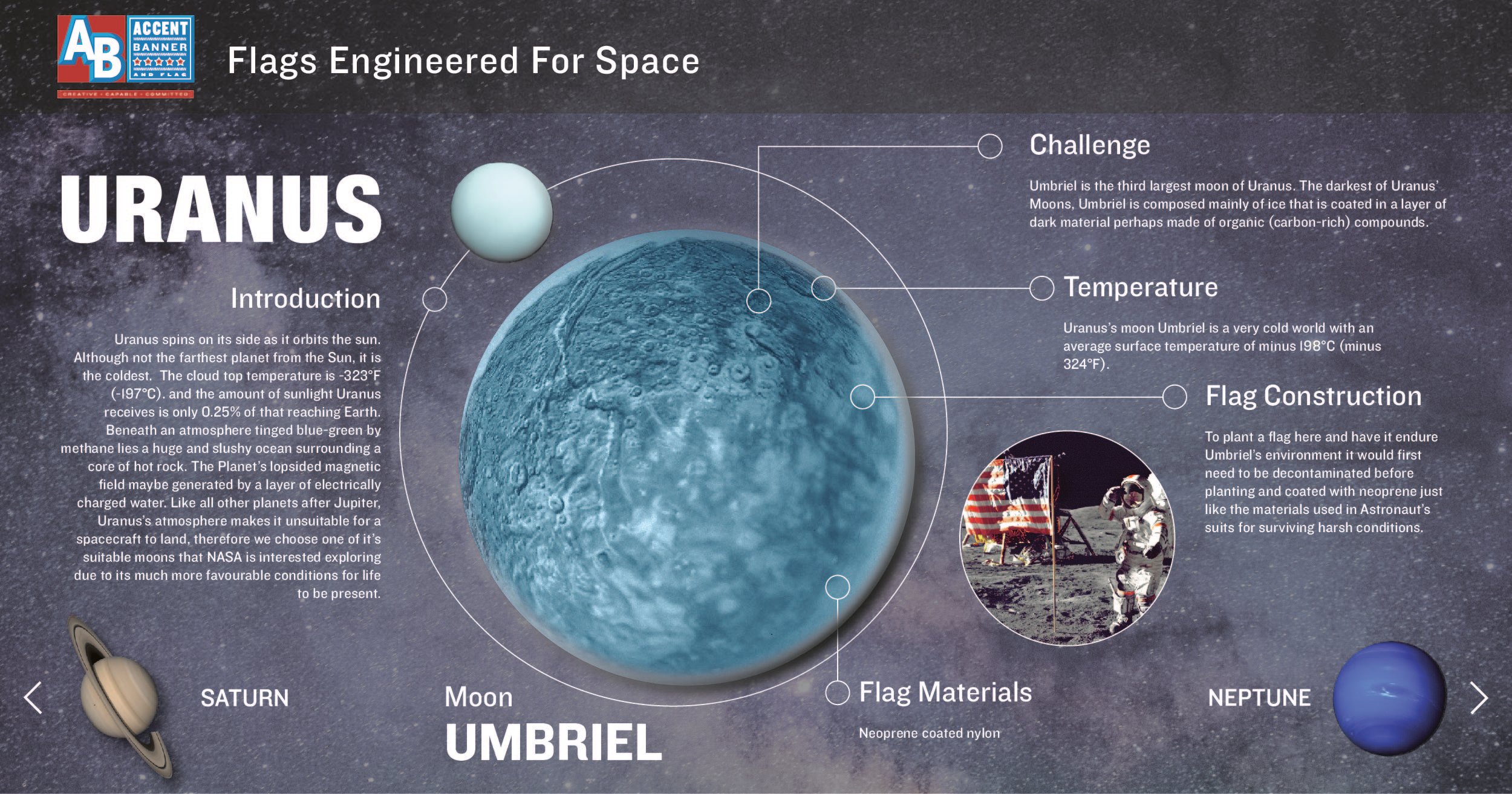
Introduction
Uranus spins on its side as it orbits the sun. Although not the farthest planet from the Sun, it is the coldest. The cloud top temperature is -323°F (-197°C). and the amount of sunlight Uranus receives is only 0.25% of that reaching Earth. Beneath an atmosphere tinged blue-green by methane lies a huge and slushy ocean surrounding a core of hot rock. The Planet’s lopsided magnetic field maybe generated by a layer of electrically charged water. Like all other planets after Jupiter, Uranus’s atmosphere makes it unsuitable for a spacecraft to land, therefore we choose one of it’s suitable moons that NASA is interested exploring due to its much more favorable conditions for life to be present.
Challenge
Umbriel is the third largest moon of Uranus. The darkest of Uranus’ Moons, Umbriel is composed mainly of ice that is coated in a layer of dark material perhaps made of organic (carbon-rich) compounds.
Temperature
Uranus’s moon Umbriel is a very cold world with an average surface temperature of minus 198°C (minus 324°F).
Flag Construction
To plant a flag here and have it endure Umbriel’s environment it would first need to be decontaminated before planting and coated with neoprene just like the materials used in Astronaut’s suits for surviving harsh conditions.
Flag Materials
Neoprene coated nylon
Neptune
Moon: Triton
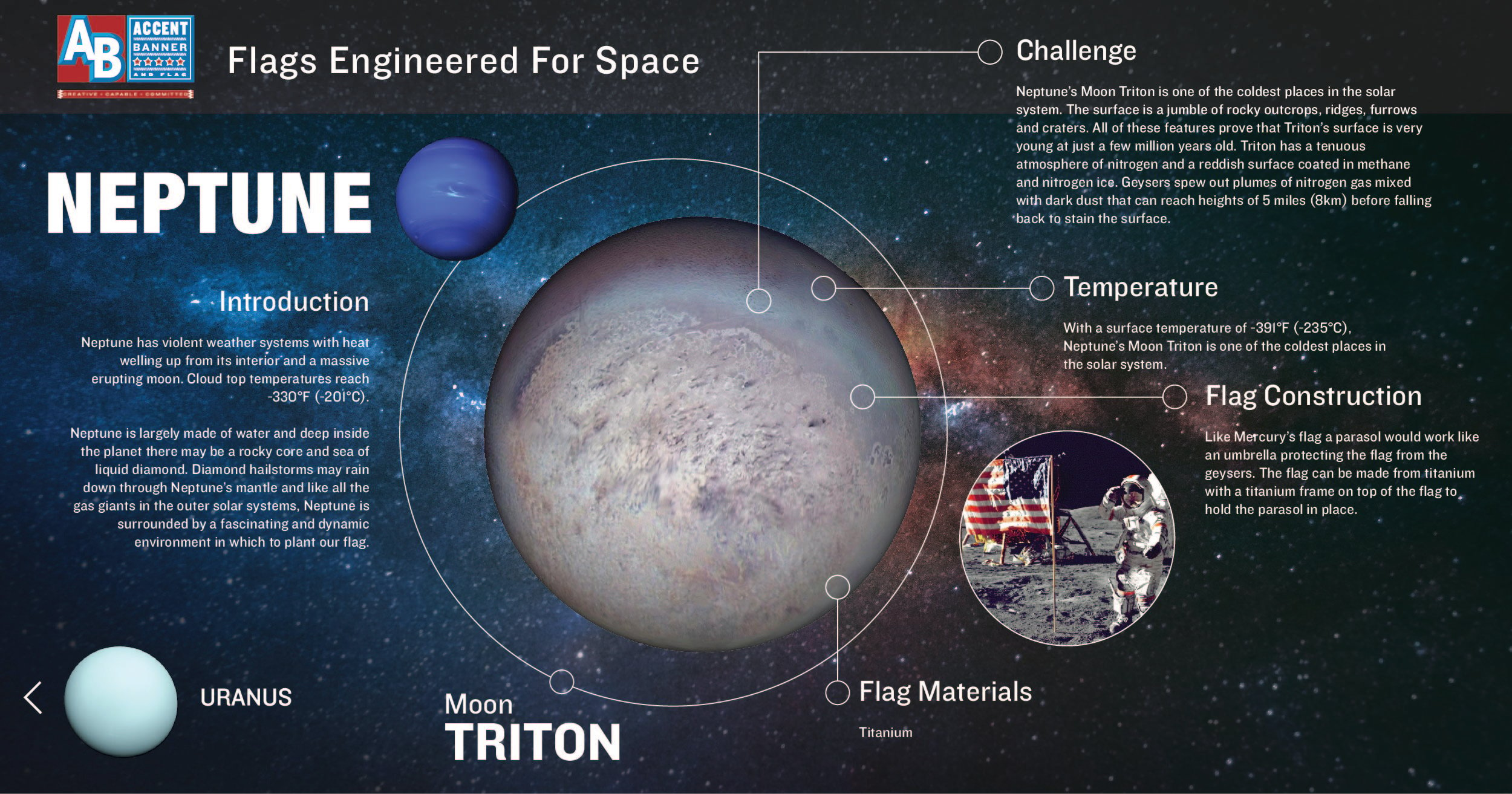
Introduction
Neptune has violent weather systems with heat welling up from its interior and a massive erupting moon. Cloud top temperatures reach -330°F (-201°C).
Neptune is largely made of water and deep inside the planet there may be a rocky core and sea of liquid diamond. Diamond hailstorms may rain down through Neptune’s mantle and like all the gas giants in the outer solar systems, Neptune is surrounded by a fascinating and dynamic environment in which to plant our flag.
Challenge
Neptune’s Moon Triton is one of the coldest places in the solar system. The surface is a jumble of rocky outcrops, ridges, furrows and craters. All of these features prove that Triton’s surface is very young at just a few million years old. Triton has a tenuous atmosphere of nitrogen and a reddish surface coated in methane and nitrogen ice. Geysers spew out plumes of nitrogen gas mixed with dark dust that can reach heights of 5 miles (8km) before falling back to stain the surface.
Temperature
With a surface temperature of -391°F (-235°C), Neptune’s Moon Triton is one of the coldest places in the solar system.
Flag Construction
Like Mercury’s flag a parasol would work like an umbrella protecting the flag from the geysers. The flag can be made from titanium with a titanium frame on top of the flag to hold the parasol in place.
Flag Materials
Titanium
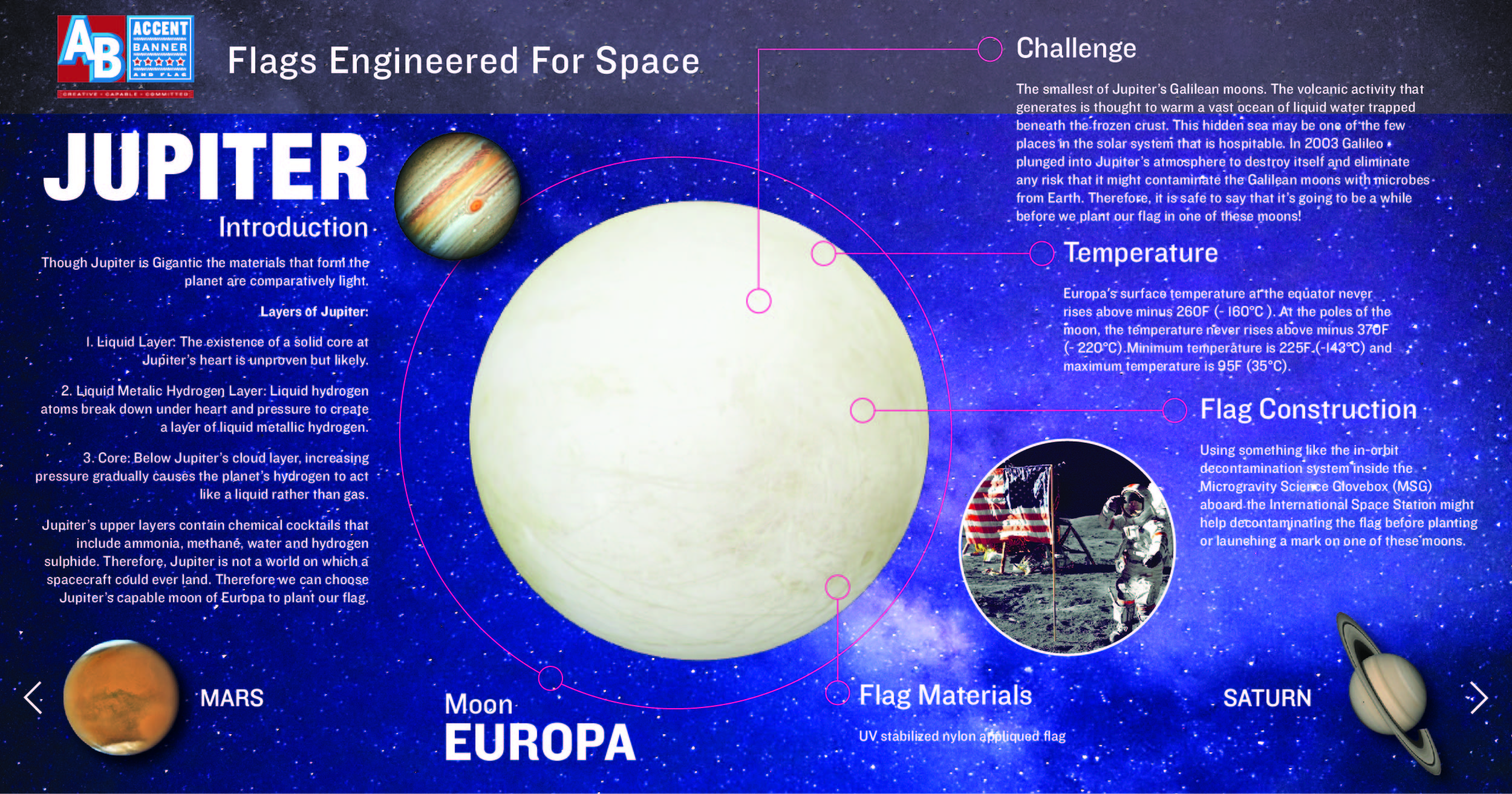
Flag for Europa (Jupiter's chosen moon)